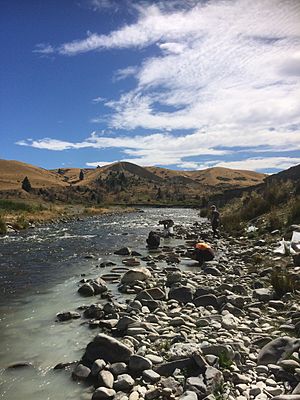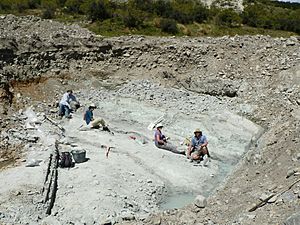St Bathans fauna facts for kids
The St Bathans fauna is a collection of fossils found in New Zealand. These fossils are from ancient animals that lived about 19 to 16 million years ago. They are found in a special rock layer in Central Otago, located on the South Island of New Zealand.
Back then, this area was covered by a large, shallow freshwater lake. This lake was huge, covering about 5600 square kilometers! Around the lake, there were big wetlands with lots of plants, including swampy forests. The weather was warm, almost like a subtropical climate in Australia. Trees like casuarinas, eucalypts, and palms grew there, along with other ancient trees.
Scientists find these fossils along the Manuherikia River and near the old gold mining town of Saint Bathans. The fossils include many different types of animals. There are fish, crocodiles, and even a relative of the tuatara (a unique New Zealand reptile). They've also found geckos, skinks, and many kinds of birds, especially waterbirds. Interestingly, there are many more parrot fossils than pigeon fossils. One special bird found here is Proapteryx, an early type of kiwi.
This ancient ecosystem was recovering after a big event called the ‘Oligocene drowning’. Millions of years before, up to 80% of New Zealand's land was underwater! The animals living around the ancient Lake Manuherikia were very unique to New Zealand. This suggests that some land must have stayed above water during the drowning event. Later, the climate got much colder and drier, which caused many of the 'subtropical' animals from St Bathans to die out. The animals that survived adapted to these changes. They became the unique creatures that people found when they first arrived in New Zealand many centuries ago.
Contents
How Scientists Find Fossils
Scientists have been studying the St Bathans fossils since the year 2000. The main scientist leading this work is Trevor H. Worthy from Flinders University in Australia. Other important scientists include Jenny Worthy from Flinders University, Paul Scofield and Vanesa De Pietri from Canterbury Museum, and Alan Tennyson from the Museum of New Zealand Te Papa Tongarewa. Their research gets funding from grants, and they also work with scientists from other universities in Australia.
Mammals
Today, New Zealand doesn't have many native land mammals, except for bats. But at St Bathans, scientists found something surprising: a very early type of mammal called the Saint Bathans mammal. They also found several kinds of bats, including a giant burrowing bat! This bat was three times bigger than today's burrowing bats and was related to bats from South America. This tells us that in the Miocene period, New Zealand had more types of small land mammals, and its bat population was much more diverse than it is now.
Birds
Ancient Birds: Kiwi and Moa
New Zealand has two famous ancient bird groups: the kiwi and the moa. Both of these groups have early relatives found in the St Bathans fossils. The kiwi ancestor, Proapteryx, was small and might have been able to fly. The moa ancestors are known from bones and eggshells. They were already large and couldn't fly, just like later moa. This suggests that moa arrived in New Zealand and lost their ability to fly much earlier than kiwis did. Kiwis seem to have arrived more recently and were still able to fly.
Shorebirds and Waders
Charadriiformes is a large group of birds that often live near water, like gulls, terns, and plovers. About 350 species exist today. Two of these birds have been found at St Bathans. One is the New Zealand lake-wanderer (Hakawai melvillei), which is related to a bird called the plains-wanderer. The other is Sansom's plover (Neilus sansomae), a plover-like bird.
Parrots
Two types of parrots have been found. One is Heracles, which is the largest parrot ever known! It weighed 7 kilograms and stood 1 meter tall. The other parrot, Nelepsittacus, has at least four different species. These parrots varied a lot in size, meaning they lived in many different ways and filled many roles in the ecosystem.
Pigeons
Scientists have found two types of ancient pigeons. Rupephaps was a large fruit-eating pigeon, possibly related to today's Hemiphaga species. The Zealandian dove was similar to the Nicobar pigeon.
Small Perching Birds
A New Zealand wren, called Kuiornis indicator, has been found in these fossil beds. It might have been similar to the modern rifleman. There are also two or three other types of small birds that scientists are still studying.
Flamingo Relatives
Palaelodids are ancient relatives of flamingos. A new species from St Bathans, Palaelodus aotearoa, was smaller than a similar species found in Australia.
Seabirds
Petrels are seabirds that belong to a group called Procellariformes, which also includes albatrosses. Today, petrels make up most of the seabird species and are the only group of birds that live entirely at sea. One type of petrel, a diving petrel called Pelecanoides miokuaka, has been found at St Bathans.
Herons
At least two types of herons have been found. Pikaihao bartlei was a type of bittern. The other, Matuku otagoense, was much larger and seems to be an early kind of heron.
Eagles and Hawks
Fossils of an eagle, similar in size to a wedge-tailed eagle, and a small hawk have also been found at St Bathans. Scientists are still working to formally describe these birds.
Rails and Their Relatives
The St Bathans adzebill (Aptornis proasciarostratus) was only a little smaller than its later relatives. There were also two types of flightless rails: the common Priscaweka parvales and the less common Litorallus livezeyi. Priscaweka parvales was no bigger than a sparrow.
Waterfowl
The St Bathans site has the most diverse collection of waterfowl (ducks, geese, swans) fossils in the world! There are at least nine species, all unique to New Zealand. These include bones that might be ancestors of the extinct New Zealand goose. Many types of stiff-tailed ducks were found, including Manuherikia lacustrina, M. minuta, M. douglasi, Dunstanneta johnstoneorum, and another undescribed species of Manuherikia. Only one type of shelduck, Miotadorna sanctibathansi, was found, but it was common. A dabbling duck called Matanas enrightii is not well known because only a few fossils have been found.
Reptiles and Amphibians
The St Bathans site is full of reptile and amphibian fossils. Some groups found here still live in New Zealand today, like leiopelmatid frogs, a sphenodontian (similar to the modern tuatara), geckos, and skinks. But there are also animals not seen in New Zealand today. These include a mekosuchine crocodile that could be up to 3 meters long! They also found turtles, including pleurodire and meiolaniid turtles. This suggests that New Zealand had many more types of reptiles and amphibians in this ancient time, probably because the climate was much warmer than it is now.
Fish
Most of the bones found at St Bathans are from freshwater fish. These include ancient relatives of today's bullies, galaxiids, and the extinct New Zealand grayling.
Water Bugs and Shells
Besides fish, the ancient Lake Manuherikia was home to many shellfish, like freshwater mussels, and freshwater crayfish. A new species of freshwater limpet, Latia manuherikia, was found and described in 2011. This was the first time this type of fossil was found and the first time this genus was recorded in the South Island.
Animals Not Found at St Bathans
It's interesting to note which animals are NOT found in the St Bathans fossils. These include marsupials (like kangaroos), snakes, certain types of lizards (like agamid and varanid lizards), lungfish, eels, and cockatoos. Also, almost all types of Australian honeyeaters are missing, except for the ancestors of New Zealand's bellbirds and tui.



